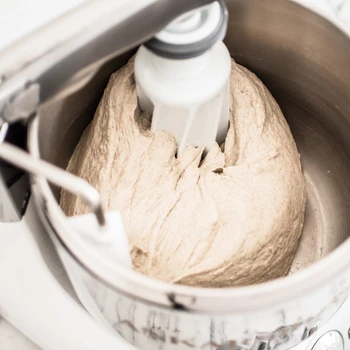There are just two essential ingredients for baking a loaf of bread: flour and water.
Using flour and water, you can start and feed a sourdough, then mix with even more water and flour, and then bake a finished bread. It’s pretty amazing!
Wheat flour consists mainly of starch and gluten. Starch is a carbohydrate, while gluten is composed of proteins.
Gluten is found in different amounts in different types of flour. Bakers refer to a flour with a low proportion of gluten as “weak,” and one with a high proportion of gluten as “strong.”
A weak flour is best for soft cakes, pie crusts and cookies that are airy or crispy. A strong flour is best for pizza dough or other Italian breads, as gluten provides greater elasticity. Wheat flour is an example of a weak flour, while durum wheat is a strong.
Quick chemistry lesson:
When you mix flour and water, the starch and protein in the flour absorbs the liquid and begins to swell. This creates a dough that consists of an adhesive (starch) and a flexible building material (gluten). When the dough is heated, these building materials solidify, so the ”glue” dries and can no longer absorb liquid. Now it becomes a loaf of bread.
Types of Flour
Wheat flour, also called kernel wheat flour, is the most common type of flour. The wheat grain is finely ground and sieved, so only the core of the wheat grain is used in baking. Wheat flour is the flour that is suitable for most uses, such as soft cakes, cookies and buns.
Spelled flour, also called spelt flour, is similar to wheat flour but has a much higher protein content. It is a finely ground and sifted flour of an ancient wheat variety, with saturating properties. This type of flour is the easiest to use, and it can usually be substituted for wheat flour in recipes. Note that the amount may need to be adjusted, because spelled flour can absorb more liquid.
Spelled and wheat flour are also available as whole grain varieties.
Durum wheat flour is a hard wheat with extra strong protein. It has a yellowish color and offers a full-bodied taste. Durum is excellent for pasta or as a blending flour for pizza or other Italian bread.
Graham flour is a coarse-ground wholemeal flour of wheat, rich in fiber, minerals and iron. Graham flour is best suited for coarser breads. It mixes well with other flours such as wheat flour, resulting in a bread that does not become too compact.
Rye flour is a coarse-ground wholemeal flour of rye, rich in fiber, minerals and iron. Rye flour is well suited for scalding before baking. Scalding means pouring boiling hot water over the flour and letting it stand for a few hours. Meanwhile, the flour absorbs extra water, which results in a softer bread.
Rye flour should also be mixed with another flour, which as wheat flour, to avoid breads that are too compact. Rye flour is also available as finely ground.
Rye sieve is a mixture of finely ground sifted wheat flour and finely ground rye flour. It consists of a larger amount of wheat and a smaller amount of rye, and it provides softer and tasty bread.
Barley flour is a finely ground flour of peeled barley. It is high in fiber and suitable for slightly coarser breads and crispbread.
Wholemeal flour. The difference between sifted and wholemeal flour is how much of the grain is used. The whole grain variant uses the whole grain, including seed and peel, while the sifted variety only consists of the core. Whole grain flour contains a larger amount of vitamins, minerals and dietary fiber.

Storage
Flour should be stored dry and not hotter than room temperature. If the flour has been heated, the fat in the flour turns rancid and has an unpleasant aftertaste. When flour is stored properly, it normally lasts longer than the date stamp.
Weights and Measures
Because flour is packed differently, it should be measured by weight instead of volume. If you do not have a scale and use a measuring cup, make sure the flour is fluffy. Pour it into a bowl before scooping it up, and do not knock the flour into the measuring cup to avoid the risk of adding too much flour.

Change flour type
Different types of flour have different properties, so they cannot always be substituted. Both taste and texture are affected. Wholemeal flour can often be exchanged for the corresponding amount of other wholemeal flour, for example 50 g graham flour for 50 g rye flour.
Sifted spelled flour and sifted wheat flour can usually be substituted for each other. Keep in mind, however, that spelled flour has a little more flavor, which may not work for all pastries.
The easiest way is to try replacing some of the wheat flour with a flour with richer fiber, and then test the result.




